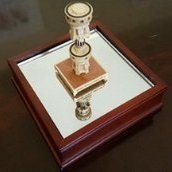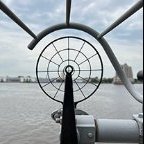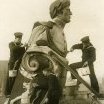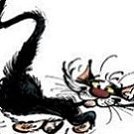Supplies of the Ship Modeler's Handbook are running out. Get your copy NOW before they are gone! Click on photo to order.
×

Charter33
-
Posts
454 -
Joined
-
Last visited
Reputation Activity
-
 Charter33 reacted to xken in What's happening here? clamp stains
Charter33 reacted to xken in What's happening here? clamp stains
You can wipe both the wood and the rubber clamping faces with acetone. The wood can be lightly sanded as well.
-
 Charter33 got a reaction from Canute in What's happening here? clamp stains
Charter33 got a reaction from Canute in What's happening here? clamp stains
The jaws were made by injecting heat softened rubberized plastic into a metal female mould sometimes called a 'die'. Once the material has cooled it hardens and the die is opened so the product, in this case the jaw, can be removed. To help get this item out the inner polished surface of the die is first sprayed with a fine mist of 'releasing agent' that helps prevent the liquid plastic from sticking to the metal. It's the remnants of this spray that might have caused the discoloring of the wood.
-
 Charter33 got a reaction from Canute in What's happening here? clamp stains
Charter33 got a reaction from Canute in What's happening here? clamp stains
Another thought - your clamp looks pretty new, and the jaws appear to have been injection-moulded. Another possibility could be that there is still some residue of the 'releasing agent' from this manufacturing process on the jaws. I have a feeling that the agent is silicon based, but I could be wrong. Light sanding ought to get rid of it. Good luck!
-
 Charter33 got a reaction from Canute in What's happening here? clamp stains
Charter33 got a reaction from Canute in What's happening here? clamp stains
Just another thought - was the hull in direct sunlight while in the clamps? It's surprising how quickly some timbers change colour, lighter or darker, when exposed to daylight.
-
 Charter33 got a reaction from mtaylor in What's happening here? clamp stains
Charter33 got a reaction from mtaylor in What's happening here? clamp stains
Just another thought - was the hull in direct sunlight while in the clamps? It's surprising how quickly some timbers change colour, lighter or darker, when exposed to daylight.
-
 Charter33 got a reaction from EJ_L in Fast Patrol Launch by Steve 12345 - Aerokits/KeilKraft
Charter33 got a reaction from EJ_L in Fast Patrol Launch by Steve 12345 - Aerokits/KeilKraft
Hi Steve,
Really enjoying following this 'retro' build - the finish on the deck is impressive, as is the rate of progress you're making!
Keep up the great work.
Cheers,
Graham
-
 Charter33 got a reaction from Nirvana in Fast Patrol Launch by Steve 12345 - Aerokits/KeilKraft
Charter33 got a reaction from Nirvana in Fast Patrol Launch by Steve 12345 - Aerokits/KeilKraft
Hi Steve,
Really enjoying following this 'retro' build - the finish on the deck is impressive, as is the rate of progress you're making!
Keep up the great work.
Cheers,
Graham
-
 Charter33 got a reaction from Steve 12345 in Fast Patrol Launch by Steve 12345 - Aerokits/KeilKraft
Charter33 got a reaction from Steve 12345 in Fast Patrol Launch by Steve 12345 - Aerokits/KeilKraft
Hi Steve,
Really enjoying following this 'retro' build - the finish on the deck is impressive, as is the rate of progress you're making!
Keep up the great work.
Cheers,
Graham
-
 Charter33 reacted to jablackwell in Sopwith F.1 Camel by jablackwell - Model Airways - WOOD
Charter33 reacted to jablackwell in Sopwith F.1 Camel by jablackwell - Model Airways - WOOD
The prop is made from a laminate of laser-cut pieces, then sanded to shape.
-
 Charter33 reacted to jablackwell in Sopwith F.1 Camel by jablackwell - Model Airways - WOOD
Charter33 reacted to jablackwell in Sopwith F.1 Camel by jablackwell - Model Airways - WOOD
.... and where I am today: working on the upper wing. There are a LOT of laser cut wing ribs that need sanding and such. It is a messy bit of work with the char going all over the place. I have finished adding the rib caps to each rib, and am now working on getting them aligned into their spars. That's it! More as this progresses.
~john
-
 Charter33 reacted to md1400cs in Wasa by md1400cs - FINISHED - Corel - 1:75
Charter33 reacted to md1400cs in Wasa by md1400cs - FINISHED - Corel - 1:75
Hi Mates,
He are some updated full views as of today. Always thanks for dropping by.
-
 Charter33 reacted to GDM67 in HMS Naiad 1797 by GDM67 - 1:60 - using Ed Tosti Books
Charter33 reacted to GDM67 in HMS Naiad 1797 by GDM67 - 1:60 - using Ed Tosti Books
Hi All, I am now 565 hours into the journey of Naiad over the last 16-months. Feeling good about where I am thus far. Since my last post, I have completed the gun ports on the p/s and have completed the sills on the s/b side.
In this first photo, is my small cutting board clamped to the build board. Note the half cup in the far corner. This is screwed to the board and I insert the larger cup of water in it. I use the water to wash off excess glue. I was tired of spilling it all the time. Also, I mounted a pencil holder and caliper holder to each side of the build board. I am trying to train myself to put these items back after each use. I figure this will save me thousands of hours of having to looking for pencils and calipers. (I don't know why this text got underlined, oh well...)
I built these measuring calipers at the start of the build as recommended by Ed. They are lap jointed and pinned and have proved to be invaluable. I used scrap babinga wood. Recently, I added a brass strip for the screw to clamp down on. This has limited the movement of the caliper once tightened.
As I placed each sill, I would use strips of bass wood as a "winding stick" to check for level from sill to sill. I am very happy with the results and have recreated the slope of the sills as outlined in the plans. There is a gentle rise at the ends of the ship with a low-level valley at midship. There is probably a nautical term for this sweep. I still need to fair the inside of the top timbers.
While this picture is upside down, it shows the squareness of the gun ports. I cannot emphasize enough that each piece you place is of great importance to the overall symmetry in a build like this. Mistakes, no matter how random or remote will likely be magnified somewhere else in the build.
This is just an exterior portside view of the gun ports and illustrates the gentle sweep of the ports. Yes, that's a dead rat hanging from the light... fake of course...
I used pinstripe tape to establish the fair sweep of the sills. The sills remain horizontal throughout the ship, the sweep is very subtle.
You will note the use of a spacer block for the ports. I found this essential I getting the correct length and height of each port. I colored the block so I could easily find it among all my scraps. Yes, I uploaded these photos backwards...
Next on the to do list is to finish the upper sills on the s/b side, rework all the spacers within the hull so they have a uniform sweep, cut the top timbers on the s/b to length. I then plan to sit down with the hull during our family vacation this summer in the mountains and go over it frame by frame. I will spend my early mornings for those 10 days with scrapers, files, and steel wool. I am looking forward to those quiet moments on the deck, sipping coffee and filing away - long before the kids get up!
Thanks for following along.
Gary
-
 Charter33 reacted to Gaetan Bordeleau in 74-gun ship by Gaetan Bordeleau - 1:24
Charter33 reacted to Gaetan Bordeleau in 74-gun ship by Gaetan Bordeleau - 1:24
Before assembling the frames, fore and aft ends are began.
Actually working at the aft.
It is a long work which goes like this: try, sand, fit...
It is a long ladder to climb, the more level, the more precise parts will be adjusted.
The only question to ask is when is it adjusted enough.
Continuation at the aft section will continue to receive some parts.
Only after ''middle frames'' will be assembled
-
 Charter33 got a reaction from CraigVT in HMS Triton by Charter33 - Complete model - POF - 1:48 Scale
Charter33 got a reaction from CraigVT in HMS Triton by Charter33 - Complete model - POF - 1:48 Scale
Hi,
The first step is often the hardest ….
I hope to undertake this challenge of building my first POF ship in order to develop my practical skills and learn new techniques - as well as ending up with a (hopefully) impressive final model. I’ve been preparing for a month or so – downloading the plans for the keel, getting them printed and sourcing the wood.
My choice of timber is cherry for the keel and frames, maple for the false keel and other components further down the line and I also have some black walnut in store.
The timber as purchased:
A strip of each cut off, split and planed down to 8 mm.
Ready to start ….
The first component I decided to make was the aft deadwood.
Patterns cut out and glued onto the cherry with ‘Spray Mount’. I’ve found that this holds the paper in place well enough without leaving any residue on the surface once removed. A couple of times the paper lifted while a piece was being worked but this was spotted and dealt with before errors occurred.
After initial cutting out with a band saw edges were refined with a combination of a band facer and drum sander.
I have read about, and liked, the technique of enhancing wood joints with permanent marker pens and decided to experiment with black and brown pens on some off-cuts. To say the difference is subtle would be a wild exaggeration! Blowed if I could tell the difference….
The pieces were glued together, cleaned up and the ‘steps’ marked prior to the waste wood being removed with chisels.
My first attempt. I’m leaving the final shaping to the sides until much more of the keel has been completed in order to try and get my head around how much wood needs to be removed.
I have also been working on making a building board.
Before I work on progressing further could someone confirm whether or not this project has been opened to new members again, please? I’m a bit confused by the message saying that it is on the ‘Forum’ front page and the one at the top of the ‘Cross section’ thread saying it’s temporarily closed.
In no way is the fact that this project has no big glossy box to smuggle through the back door while the Admiral isn’t looking, thus avoiding the inevitable questions of ‘how much?’ or ‘and where is it going to go when it’s finished’ has absolutely no bearing on my decision to get actively involved ….. honest…
Cheers,
Graham.
-
 Charter33 reacted to dj.bobo in RNLB Ruby & Arthur Reed 2 by dj.bobo - FINISHED
Charter33 reacted to dj.bobo in RNLB Ruby & Arthur Reed 2 by dj.bobo - FINISHED
Good evening to everyone, work continues with searchlight . This time I worked in acrylic and a little with brass. I polished the acrylic with the flame and applied a layer of chrome paint, followed by the white paint finish.
All the best .
Adrian.
-
 Charter33 got a reaction from Jorge Diaz O in HMS Triton by Charter33 - Complete model - POF - 1:48 Scale
Charter33 got a reaction from Jorge Diaz O in HMS Triton by Charter33 - Complete model - POF - 1:48 Scale
Hi,
The first step is often the hardest ….
I hope to undertake this challenge of building my first POF ship in order to develop my practical skills and learn new techniques - as well as ending up with a (hopefully) impressive final model. I’ve been preparing for a month or so – downloading the plans for the keel, getting them printed and sourcing the wood.
My choice of timber is cherry for the keel and frames, maple for the false keel and other components further down the line and I also have some black walnut in store.
The timber as purchased:
A strip of each cut off, split and planed down to 8 mm.
Ready to start ….
The first component I decided to make was the aft deadwood.
Patterns cut out and glued onto the cherry with ‘Spray Mount’. I’ve found that this holds the paper in place well enough without leaving any residue on the surface once removed. A couple of times the paper lifted while a piece was being worked but this was spotted and dealt with before errors occurred.
After initial cutting out with a band saw edges were refined with a combination of a band facer and drum sander.
I have read about, and liked, the technique of enhancing wood joints with permanent marker pens and decided to experiment with black and brown pens on some off-cuts. To say the difference is subtle would be a wild exaggeration! Blowed if I could tell the difference….
The pieces were glued together, cleaned up and the ‘steps’ marked prior to the waste wood being removed with chisels.
My first attempt. I’m leaving the final shaping to the sides until much more of the keel has been completed in order to try and get my head around how much wood needs to be removed.
I have also been working on making a building board.
Before I work on progressing further could someone confirm whether or not this project has been opened to new members again, please? I’m a bit confused by the message saying that it is on the ‘Forum’ front page and the one at the top of the ‘Cross section’ thread saying it’s temporarily closed.
In no way is the fact that this project has no big glossy box to smuggle through the back door while the Admiral isn’t looking, thus avoiding the inevitable questions of ‘how much?’ or ‘and where is it going to go when it’s finished’ has absolutely no bearing on my decision to get actively involved ….. honest…
Cheers,
Graham.
-
 Charter33 got a reaction from harvey1847 in HMS Triton by Charter33 - Complete model - POF - 1:48 Scale
Charter33 got a reaction from harvey1847 in HMS Triton by Charter33 - Complete model - POF - 1:48 Scale
Hi,
The first step is often the hardest ….
I hope to undertake this challenge of building my first POF ship in order to develop my practical skills and learn new techniques - as well as ending up with a (hopefully) impressive final model. I’ve been preparing for a month or so – downloading the plans for the keel, getting them printed and sourcing the wood.
My choice of timber is cherry for the keel and frames, maple for the false keel and other components further down the line and I also have some black walnut in store.
The timber as purchased:
A strip of each cut off, split and planed down to 8 mm.
Ready to start ….
The first component I decided to make was the aft deadwood.
Patterns cut out and glued onto the cherry with ‘Spray Mount’. I’ve found that this holds the paper in place well enough without leaving any residue on the surface once removed. A couple of times the paper lifted while a piece was being worked but this was spotted and dealt with before errors occurred.
After initial cutting out with a band saw edges were refined with a combination of a band facer and drum sander.
I have read about, and liked, the technique of enhancing wood joints with permanent marker pens and decided to experiment with black and brown pens on some off-cuts. To say the difference is subtle would be a wild exaggeration! Blowed if I could tell the difference….
The pieces were glued together, cleaned up and the ‘steps’ marked prior to the waste wood being removed with chisels.
My first attempt. I’m leaving the final shaping to the sides until much more of the keel has been completed in order to try and get my head around how much wood needs to be removed.
I have also been working on making a building board.
Before I work on progressing further could someone confirm whether or not this project has been opened to new members again, please? I’m a bit confused by the message saying that it is on the ‘Forum’ front page and the one at the top of the ‘Cross section’ thread saying it’s temporarily closed.
In no way is the fact that this project has no big glossy box to smuggle through the back door while the Admiral isn’t looking, thus avoiding the inevitable questions of ‘how much?’ or ‘and where is it going to go when it’s finished’ has absolutely no bearing on my decision to get actively involved ….. honest…
Cheers,
Graham.
-
 Charter33 got a reaction from G.L. in HMS Triton by Charter33 - Complete model - POF - 1:48 Scale
Charter33 got a reaction from G.L. in HMS Triton by Charter33 - Complete model - POF - 1:48 Scale
Hi,
The first step is often the hardest ….
I hope to undertake this challenge of building my first POF ship in order to develop my practical skills and learn new techniques - as well as ending up with a (hopefully) impressive final model. I’ve been preparing for a month or so – downloading the plans for the keel, getting them printed and sourcing the wood.
My choice of timber is cherry for the keel and frames, maple for the false keel and other components further down the line and I also have some black walnut in store.
The timber as purchased:
A strip of each cut off, split and planed down to 8 mm.
Ready to start ….
The first component I decided to make was the aft deadwood.
Patterns cut out and glued onto the cherry with ‘Spray Mount’. I’ve found that this holds the paper in place well enough without leaving any residue on the surface once removed. A couple of times the paper lifted while a piece was being worked but this was spotted and dealt with before errors occurred.
After initial cutting out with a band saw edges were refined with a combination of a band facer and drum sander.
I have read about, and liked, the technique of enhancing wood joints with permanent marker pens and decided to experiment with black and brown pens on some off-cuts. To say the difference is subtle would be a wild exaggeration! Blowed if I could tell the difference….
The pieces were glued together, cleaned up and the ‘steps’ marked prior to the waste wood being removed with chisels.
My first attempt. I’m leaving the final shaping to the sides until much more of the keel has been completed in order to try and get my head around how much wood needs to be removed.
I have also been working on making a building board.
Before I work on progressing further could someone confirm whether or not this project has been opened to new members again, please? I’m a bit confused by the message saying that it is on the ‘Forum’ front page and the one at the top of the ‘Cross section’ thread saying it’s temporarily closed.
In no way is the fact that this project has no big glossy box to smuggle through the back door while the Admiral isn’t looking, thus avoiding the inevitable questions of ‘how much?’ or ‘and where is it going to go when it’s finished’ has absolutely no bearing on my decision to get actively involved ….. honest…
Cheers,
Graham.
-
 Charter33 got a reaction from Heinrich der Seefahrer in HMS Triton by Charter33 - Complete model - POF - 1:48 Scale
Charter33 got a reaction from Heinrich der Seefahrer in HMS Triton by Charter33 - Complete model - POF - 1:48 Scale
Hi,
The first step is often the hardest ….
I hope to undertake this challenge of building my first POF ship in order to develop my practical skills and learn new techniques - as well as ending up with a (hopefully) impressive final model. I’ve been preparing for a month or so – downloading the plans for the keel, getting them printed and sourcing the wood.
My choice of timber is cherry for the keel and frames, maple for the false keel and other components further down the line and I also have some black walnut in store.
The timber as purchased:
A strip of each cut off, split and planed down to 8 mm.
Ready to start ….
The first component I decided to make was the aft deadwood.
Patterns cut out and glued onto the cherry with ‘Spray Mount’. I’ve found that this holds the paper in place well enough without leaving any residue on the surface once removed. A couple of times the paper lifted while a piece was being worked but this was spotted and dealt with before errors occurred.
After initial cutting out with a band saw edges were refined with a combination of a band facer and drum sander.
I have read about, and liked, the technique of enhancing wood joints with permanent marker pens and decided to experiment with black and brown pens on some off-cuts. To say the difference is subtle would be a wild exaggeration! Blowed if I could tell the difference….
The pieces were glued together, cleaned up and the ‘steps’ marked prior to the waste wood being removed with chisels.
My first attempt. I’m leaving the final shaping to the sides until much more of the keel has been completed in order to try and get my head around how much wood needs to be removed.
I have also been working on making a building board.
Before I work on progressing further could someone confirm whether or not this project has been opened to new members again, please? I’m a bit confused by the message saying that it is on the ‘Forum’ front page and the one at the top of the ‘Cross section’ thread saying it’s temporarily closed.
In no way is the fact that this project has no big glossy box to smuggle through the back door while the Admiral isn’t looking, thus avoiding the inevitable questions of ‘how much?’ or ‘and where is it going to go when it’s finished’ has absolutely no bearing on my decision to get actively involved ….. honest…
Cheers,
Graham.
-
 Charter33 reacted to Torbogdan in Fokker Dr.I by Torbogdan - FINISHED - Model Airways
Charter33 reacted to Torbogdan in Fokker Dr.I by Torbogdan - FINISHED - Model Airways
Some parts, bolts for the propeller, engine, fuel tank partly done, machine guns, carburetor and air intakes and parts for the pilots seat.
Up to the left are two pieces of flat aluminum, they are the missing parts for the fuel tank. I, of course, bent them "the wrong way". Trying to bend it back, it broke of course. Thin aluminum can´t bend often without breaking... I´ll drink a beer tomorrow and use the can for repair material
Som
Cockpit are slowly getting done, the grey box is the MG ammo box.
Another angle. Today was a productive day. It went slow but at least all went according to plan, no mistakes!
-
 Charter33 got a reaction from CaptnBirdseye in HMS Victory by Charter33 - Caldercraft - Scale 1:72
Charter33 got a reaction from CaptnBirdseye in HMS Victory by Charter33 - Caldercraft - Scale 1:72
Thanks for dropping by Marc, here is yet another jig!
Decision made – I’m going to stick with the approach given in the manual and work up from the keel – thanks Steve for the ‘nudge’ that finally swayed me.
After several sessions I have now fitted about 10% of the copper plates. It was always going to be a long haul, but so far it’s been fairly straight forward and surprisingly therapeutic!
One aspect that has been giving me food for thought was how to deal with the keel. I wanted to cover the bottom of it with plates folded evenly over the edges. With the keel 5 mm thick and the plates 6 mm wide this means a ‘return’ of 0.5 mm on the side of each plate. Early attempts with flat pliers and then brass soft jaws in a bench vice failed miserably ……
With approximately 60 plates needing to be shaped some kind of simple former was going to be required. This is what I came up with:
The main body consists of two 60 mm lengths of 5 mm square mild steel bar. The lower part has a shallow recess equal to the length of a copper plate filed into it while the upper bar has two grooves filed in with a ‘three square’ needle file to provide clearance for the raised rivet heads that run across the ends of the plates. I couldn’t find any small diameter socket headed machine screws to apply the clamping pressure in the workshop so resorted to cutting M3 x .5 threads on the pins of a couple of plated brass ‘push buttons’ from old 1970’s telephones that were rattling around at the back of a cupboard – knew they’d come in useful one day ….. Clearance holes in the top bar and suitably threaded holes in the lower bar finish the former.
The plate is put in place, but first checked to ensure that the rows of ‘rivets’ on the side are equally spaced from the edges – this sometimes varies considerably.
After clamping the protruding edges are pushed by thumb in the right direction and then a piece of softwood dowel is rolled along the edge to complete the bend.
... and the job's a goodun...
I hope this will be of some use to other builders.
Cheers,
Graham.
-
 Charter33 got a reaction from CraigVT in HMS Victory by Charter33 - Caldercraft - Scale 1:72
Charter33 got a reaction from CraigVT in HMS Victory by Charter33 - Caldercraft - Scale 1:72
Hi,
Tackling the wales proved to be fairly straight forward.
After taking measurements from the plan and transferring them onto the hull, a strip of wood was pinned on these marks and, after a little ‘fine adjustment’, the curved lines were marked on.
The majority of the prepared pieces fitted straight on and CA glue was used for bonding. At the bow and stern some additional shaping was required together with gentle bending with plank ‘nippers’.
These photographs show the work in progress and the final results.
Drifting randomly through the wide ranging posts on this site the other evening I came across many superb examples of the model makers art that reminded me of a time, back in the mid-1960s, when the ‘Birthday treat’ of choice was a trip across London to visit the Cutty Sark followed by the model ship galleries at the National Maritime Museum, Greenwich. It was these amazing models, mostly ‘plank on frame’, that sparked a lifetime’s interest. Sadly these wonderfully detailed models are no longer on display although they can be examined to some extent on-line.
Why am I rambling on about this? Well – one of the sections I was exploring that started this reminiscing was the HMS Triton project. WOW! My head is telling me to keep focused, the ‘Victory’ journey has a long way still to go, my heart is saying – what a challenge! The build logs, both completed models and works in progress, are very impressive. It costs nothing to start planning… the keel plans are easily down loaded,…. and there just happens to be a very helpful and friendly print shop less than a mile away ……mmmm
Meanwhile, it time to start lining the gun ports.
-
 Charter33 reacted to dj.bobo in RNLB Ruby & Arthur Reed 2 by dj.bobo - FINISHED
Charter33 reacted to dj.bobo in RNLB Ruby & Arthur Reed 2 by dj.bobo - FINISHED
Good evening to everyone, work continues with deks lamps .
Have a nice evening.
Adrian .
-
 Charter33 got a reaction from EricWilliamMarshall in HMS Victory by Charter33 - Caldercraft - Scale 1:72
Charter33 got a reaction from EricWilliamMarshall in HMS Victory by Charter33 - Caldercraft - Scale 1:72
Hi Folks,
The last of the three ’Victory material’ challenges is the construction of three ‘pedestals’ on which the finished model will be mounted. Final completion of the model is still a considerable way off – but retirement is probably going to strike before this and it makes sense to tackle the task while access to the workshop equipment is still possible. (well, that’s my excuse and I’m sticking to it…)
There are a number of unknown factors that could affect this mini project: Will it be possible to turn the metal in the first place? – I’ve come across some metals in the past that have a skin so hard it knackers the cutting tool in seconds, and what kind of finish will it be possible to achieve? Only one way to find out.
The rod as supplied…..pretty uninspiring, about four inches long and a little less than an inch in diameter.
First job is to face off the ends of the bar.
…..then skim the bar to remove the corrosion. First question answered – oh yes, it will machine. It cuts in a similar way to mild steel and is relatively soft ….
The finished billet is then cut into three blanks…
I’ve made the decision to turn the base of each column down and thread them M10 x 1.5 initially to enable each piece to be mounted on a mandrel for further machining, meaning I won’t have to hold the blank directly in the lathe’s chuck, and eventually to fix the pedestals to the wooden base.
Mounted between the mandrel and a revolving centre, each blank is machined to profile with a round nosed tool. The final finish is achieved using emery cloth followed by 600 grade ‘wet and dry’, and finally the same grade of abrasive paper lubricated with a light oil.
Just like turning legs for Windsor chairs, the first one is quite straight forward – its’ getting the others to match that provides the challenge!
Last task is machining the slot for the keel to fit into, using a universal milling machine fitted with a 4mm slotting bit. The final slot was 6mm wide. The pedestals have been previously been drilled on the lathe to take the 1/8th” silver steel rods that will extend up into the tubes set into the hull structure (see my first ‘post’).
Done and dusted….
Cheers for now,
Graham
-
 Charter33 got a reaction from maddog33 in HMS Victory by Charter33 - Caldercraft - Scale 1:72
Charter33 got a reaction from maddog33 in HMS Victory by Charter33 - Caldercraft - Scale 1:72
Thanks for dropping by Marc, here is yet another jig!
Decision made – I’m going to stick with the approach given in the manual and work up from the keel – thanks Steve for the ‘nudge’ that finally swayed me.
After several sessions I have now fitted about 10% of the copper plates. It was always going to be a long haul, but so far it’s been fairly straight forward and surprisingly therapeutic!
One aspect that has been giving me food for thought was how to deal with the keel. I wanted to cover the bottom of it with plates folded evenly over the edges. With the keel 5 mm thick and the plates 6 mm wide this means a ‘return’ of 0.5 mm on the side of each plate. Early attempts with flat pliers and then brass soft jaws in a bench vice failed miserably ……
With approximately 60 plates needing to be shaped some kind of simple former was going to be required. This is what I came up with:
The main body consists of two 60 mm lengths of 5 mm square mild steel bar. The lower part has a shallow recess equal to the length of a copper plate filed into it while the upper bar has two grooves filed in with a ‘three square’ needle file to provide clearance for the raised rivet heads that run across the ends of the plates. I couldn’t find any small diameter socket headed machine screws to apply the clamping pressure in the workshop so resorted to cutting M3 x .5 threads on the pins of a couple of plated brass ‘push buttons’ from old 1970’s telephones that were rattling around at the back of a cupboard – knew they’d come in useful one day ….. Clearance holes in the top bar and suitably threaded holes in the lower bar finish the former.
The plate is put in place, but first checked to ensure that the rows of ‘rivets’ on the side are equally spaced from the edges – this sometimes varies considerably.
After clamping the protruding edges are pushed by thumb in the right direction and then a piece of softwood dowel is rolled along the edge to complete the bend.
... and the job's a goodun...
I hope this will be of some use to other builders.
Cheers,
Graham.












.thumb.jpeg.fc5d633a7b34428fcf19419a73d56d55.jpeg)